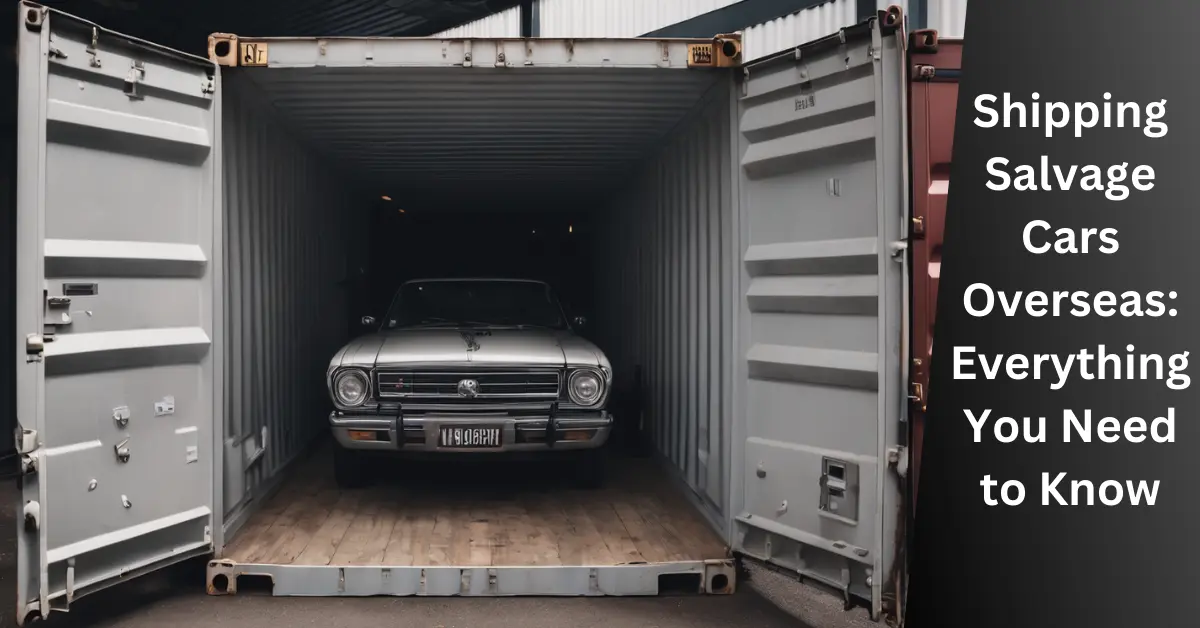Shipping salvage cars overseas can be complicated. However, with the proper guidance and understanding of the rules, it’s straightforward and could be profitable. This article demystifies transporting repairable vehicles abroad - from preparing your vehicle for transport to choosing a reliable moving service.
Ready to rev up your knowledge? Let’s dive in!
Key Takeaways
- You can save money by hauling salvage cars overseas. These vehicles cost less and are wanted in many markets.
- Prepare a non-running car for shipping, clean it, note any damage, secure loose parts, and take out the battery.
- There are three ways to ship a car : Ro-Ro or LOLO, which is cheap; container transport, which keeps cars safe in boxes; and air freight, which moves fast but costs more.
- Before you send your salvage car abroad, get good insurance, follow the customs rules of other countries, and pick an honest transport company.
Why Ship Salvage Cars Overseas?

Moving repairable vehicles overseas can offer significant benefits, such as potential cost savings, access to specific markets where these vehicles are in demand, and even environmental advantages by reducing waste.
Cost Savings
You can buy these cars at auto auctions for much less than used vehicles. They are 30% to 40% cheaper. Plus, shipping them only costs about $1,000.
That’s quite a deal! It helps you stay within budget while getting the car that suits your needs.
Access to Specific Markets
Many buyers in other countries want these types of cars, so transporting non-running vehicles overseas opens up new markets. The car’s title does not matter as much to them. This can allow you to make more money from your sale.
Transporting non-running cars is also part of the global used car trade. Buyers all over the world are looking for these vehicles. You might have a particular car that is hard to find where they live.
They may be willing to pay more for it because it is rare in their country.
Environmental Benefits
Shipping non-running cars overseas helps our planet. It cuts down on new car making. This saves a lot of energy. Plus, fewer new cars mean less pollution from factories. Non-running vehicles also cut waste.
We fix them, and they hit the road again instead of going to junk yards. Shipping them to places with rules for less car smoke also reduces worldwide smoke levels! What’s more? Old car parts get a second life by being used again or made into something new!
Costs for Shipping Different Salvaged Vehicles Overseas
| Type of Vehicle | Cost Range |
|---|---|
| Cars | $700 to $2,000 or more |
| Trucks | $1,200 to $4,000 or more |
| Motorcycles | $400 to $1,000 or less |
It’s important to remember that the costs of transporting damaged vehicles are not limited to the shipping fees. Additional expenses, such as customs duties and import taxes, may according to the destination country. It’s essential to research the laws and regulations of the country you’re transporting to and consider these expenses while calculating the overall cost.
Overall, when moving non-running vehicles overseas, it’s crucial to understand the different costs involved. Get a quote from your moving company, research the laws and regulations of the destination country, and factor in any additional expenses, such as insurance and tracking fees, to ensure a successful and stress-free moving experience.
Preparing a Salvage Car for Shipping

Before you ship a non-operational car overseas, clean it thoroughly, document any existing damage, secure loose parts securely, and disconnect the battery to ensure safe shipping.
Cleaning the Vehicle
You must clean your salvage car before moving. Let’s go over the steps to get this done.
- First, wash the outside of the car. This helps to see any damage to the body.
- Then, dry it well to keep the rust away.
- Check every spot on your car. Don’t let any dirt stay.
- Open up and vacuum inside your car next. Throw out the trash and keep it tidy.
- Use a rug or brush for floor mats and seats.
Documenting Damage
You need to write down all the damages on your non-running car before shipping. Here’s what to do:
- Take clear photos of each side of the car. Include close-ups of any damage.
- Write a list of all broken, missing, or damaged parts.
- Mark the places on a car diagram where it is damaged.
- Check if the crash structure is safe and note it down.
Securing Loose Parts
Securing loose parts on a Repairable car is essential for safe transport. Here’s how you can do it:
- First, check your car well.
- Find all loose parts like mirrors and bumpers.
- Use robust tools to attach these parts back onto the car.
- If you cannot put them back, take them out of the car.
- Put these parts in a box to keep them safe during the trip.
- Label the box so everyone handling it knows what is inside it.
- Transport drivers will then secure this box in the transport vehicle.
Disconnecting the Battery
Taking out the battery of a non-running car is very important. Here are the steps to do it:
- Find gloves. Battery acid can harm your skin.
- Look for the negative cable ( - sign). Take this off first.
- Now, take off the positive cable (+ sign).
- Take out any screws holding the battery in place.
- Lift out the battery carefully.
Choosing the Right Shipping Method
Choosing the correct transportation method is critical when moving non-operational cars overseas. Roll-on/Roll-off (Ro-Ro) is an economical option where vehicles are driven directly onto a freight ship.
If added protection is necessary, container transport might be worth considering, as your car would be enclosed in its container. Air freight is another choice and can provide fast, secure transportation for valuable non-running vehicles - but it comes with a higher cost.
Carefully weigh each option to select the most suitable method for your needs and budget.
Roll-on/Roll-off (Ro-Ro)
Roll-on/Roll-off (Ro-Ro) is a shipping way used for cars. It is also called LOLO, short for lift-on/lift-off. This method lets vehicles drive on and off the ship with ease. Ships made to do Ro-Ro are significant and can hold things like trucks, buses, or bikes.
Ro-Ro helps cars reach far places faster than when a crane lifts them onto the ship. Also, it costs less money, which makes it a good pick if you want to save some cash. Yet, only a few people use Ro-Ro even though it divides up port fees and ocean trip costs among all the cargo onboard.
However, if the car is in non-running condition, then Ro-Ro is impossible. Only Lo-Lo can be done with the help of a crane.
Container Shipping
Container transportation is one way to send repairable vehicles overseas. This method keeps your car safe inside a box. The container can take a single car or more than one, based on size. It costs between $1,500 and $5,000.
The price changes with how far the ship goes. One must secure the car in the container to avoid getting hurt during travel. This is done by blocking and bracing cargo in place inside the container.
There are rules about what you can put in containers for shipping cars overseas , too.
Air Freight
Air freight is fast, but it costs a lot. The price goes up with the size and weight of the car. You can see where your car is at all times with air freight, which is good for keeping an eye on things.
Rates change based on where you’re sending to, how heavy your car is, and what type of cargo it falls under. Lots of people pick air freight when they want their vehicles shipped fast.
Important Considerations and Regulations When Moving Salvage Cars
When moving non-running cars overseas, consider vital factors such as insurance coverage and customs requirements. You must be aware of the regulations of your destination country and choose a reputable shipping company.
Also, gather all necessary documents for international car shipment to ensure smooth transportation.
Insurance Coverage
You need good insurance to ship a salvage car overseas. This is because the car could get damaged during shipping. Luckily, most transport companies must offer insurance by law. This covers any harm that happens while your vehicle gets moved.
But you can only leave it to the transport company. As the car owner, it’s also your job to check their insurance cover age. Find out what it includes and if it’s enough for your needs.

For instance, many firms only give basic liability insurance for rebuilt, non-running cars. This lets owners drive their salvaged car legally but may need more cover for moving abroad.
Customs Requirements
You must follow all customs rules. These are the steps you take when you send a car to another country. The first thing is giving customs your original Certificate of Title or a certified copy.
This proves that you own the car. If there’s a lien on your car , and it’s leaving its home country, then more papers are needed.
Knowing both the United States and other countries’ laws about cars from other places is vital, too. There could be fees to pay in both countries! A shipping service like ShipVehicles.com can help with these tasks and ensure everything goes well.
Destination Country Regulations
Each country has laws for car imports. You need to know these before you ship a Repairable car. These rules can change the cost and the time it takes to get your car to you.
Some countries only let in new cars. Others put a limit on how old a used car can be. Some have rules about safety and pollution that your vehicle must meet. If your car does not meet these, you may need to pay more or do extra work.
Your vehicle also needs to be clean for USDA standards if you are shipping from the U.S. This means no dirt on the outside and inside of your vehicle , such as under its hood or wheels.
Selecting a Reputable Shipping Company
Picking a good auto transport company is critical for safe car transport. Do your homework on the firms you find. Look at online reviews to see what others say about them. Also, check if they have many complaints filed against them.
Ensure your chosen company is genuine and not part of any scam or fraud.
Documents Needed to Ship a Car Internationally
Shipping a car overseas needs vital paperwork. Here are the documents you must have:
When moving non-running cars overseas, there are specific documents you need to prepare to ensure a smooth clearance process. Provide the necessary paperwork to avoid delays or even the rejection of your shipment.
Here is a list of the essential documents you need to prepare when shipping repairable cars overseas:
MUST HAVE:
- Vehicle Registration Certificate - This document proves that you are the car’s legal owner.
- Two copies of government-issued I.D. This could be your passport or driver’s license.
- Title of Ownership - This document proves you can sell or transfer car ownership.
- Bill of Sale - This document details the transaction between the buyer and seller, including the final sale price.
Might Be Required:
- Export Declaration - This document is required by the Department of Commerce and is used to track U.S. exports.
- Import Declaration - This document is required by the country of destination and is used to track imported goods.
- Customs Invoice - This document details the value and description of the goods being shipped.
- Insurance Certificate - This document proves that the car is insured during transit.
- Power of Attorney - This document authorizes a customs agent or broker to act on your behalf during the clearance process.
It’s important to note that some countries may have additional requirements, such as emissions or roadworthiness certificates. Make sure to research the specific needs of the country you are shipping to and prepare all necessary documents accordingly.
Preparing the required documents can save you from unnecessary stress and delays during shipping. Double-check that all records are accurate, complete, and up-to-date before sending them to your shipping company.
What it means if your car is unsalvageable?
Your car gets tagged as unsalvageable if it is too hurt. It can’t be fixed or returned to its old look and function. The insurance company thinks the car’s repair cost is just too high.
So, they say no to covering repair costs.
This ends up making your car a total loss. It’s like telling you that your car has zero value right now. You’re dealing with a severe blow here because of this harsh reality.
The label of an ‘unsalvageable’ also takes away your chances of selling the car at home. Your vehicle earns a salvage title due to all these happenings. People tend only to buy vehicles with such titles if they have meager resale value.
Why salvage car shipping is more expensive?
The shipping of repairable cars tends to be pricier due to the specialized equipment and expertise required for safe transportation; delve into these intricate details as you continue reading.
Special equipment is required to transport salvage vehicles
Moving salvage vehicles needs special tools. This is because these cars may have been damaged. Thus, they need more care to move from one place to another. Enclosed car transport is often the best choice for these vehicles.
It helps keep the car safe during its trip. Shipping companies use special trucks and gear meant just for this job to offer this service. They have the know-how to handle such damaged cars with great care.
Shipping Vehicles From Salvage Car Auctions: Important Considerations
Before you ship your repairable car, some steps need to be taken.
- Give the place where the car will be picked up.
- Tell when the car can be picked up.
- Talk to the shipping agent early on. This makes it easy to get the car ready for its trip.
- Know key numbers like lot number, buyer number, and car VIN.
- Giving all this information ahead of time helps in a smooth transition.
Most salvage car auctions give you at least two days of free storage after you purchase the vehicle. If the vehicle is picked up after 2 days, the auction begins to charge storage at around $20 per day. Find out the last free day on your car, and avoid extra costs by picking up the vehicle before this date ends.
It’s crucial to sort out auction payments and fees before scheduling shipping. For efficient pickup preparation, provide your transport agent with all necessary details, such as lot number, buyer number, and VIN.
Remember that auctions often offer a short grace period for free post-purchase storage; daily storage costs accrue afterward. Understand that policy at repairable car auctions usually requires using a forklift to load cars onto trailers regardless of their condition.
Lastly, always check if additional requirements are needed to expedite the moving process and minimize storage fees.
Make sure all payments to the auctions are made and approved before you begin to plan to transport your vehicle. Payments could include member fees, any past due fees, or storage fees owed.
You have to pay all your fees before planning how to move your car. These costs are not just for the car itself. They also include other fees that you owe. This list gives you a guide.
- Check the total amount you must pay at the auction.
- Make sure you have paid all member fees.
- Clear any old bills you might still owe.
- Pay any storage costs if your car has been kept somewhere.
- After buying a vehicle, try to do these things within three days so no extra charges build up.
- Only after everything is paid can the car be moved from where it is stored.
Note: Provide the pickup location and the date the vehicle will be ready for pickup. The earlier you contact a shipping agent, the easier it is to prepare the car for transport. Have ready the lot number, buyer number, VIN, and any
Since we’re talking about vehicles you buy from salvage car auctions, the pickup policy and IAAI and Copart and the like typically only allow using a forklift to load the vehicle on the trailer.
At Copart and IAAI, all cars from their auctions are moved by forklift. This is the rule. It does not matter if the vehicle can be driven or not. A forklift will load the vehicle onto a trailer.
Note: Be sure to check with the auction house to find out if there are any other requirements to pick up your vehicle. It will speed up the shipping process and save you on any storage fees. Some auctions do not give tags or let you drive the cars away.
Pay on time and pick up your car quick ly so you don’t have to pay fees. If a place called Copart has your car, but you wait over five days, they will ask for a fee every day until you take it home.
Avoid these costs by being fast when picking up your vehicle.
Parting Words:
Shipping salvage cars overseas can be a smart move. It saves money and helps the earth. But getting ready and picking the right way to ship is essential. Also, understanding the rules and finding a suitable transport company matters a lot.
FAQs
What is a salvage car?
It is a vehicle that has been damaged or broken in some way and would cost more to fix than its current value.
Can I ship my salvage car overseas?
You can ship your salvage car overseas, but it requires special handling and permits from exporting and importing countries.
How much does it cost to ship a salvage car overseas?
The cost of moving a salvage car overseas varies due to factors like distance, size of the vehicle, destination port fees, and the method of shipment used.
Is there any paperwork required for shipping my salvage car?
Yes, you need certain documents, such as proof of ownership, bill of sale, and international insurance policy, for transporting your salvage car globally.
How long will it take to ship my salvaged vehicle worldwide?
Shipping times differ based on the route taken, customs clearance at ports involved, and weather conditions but generally range between 2-8 weeks.





